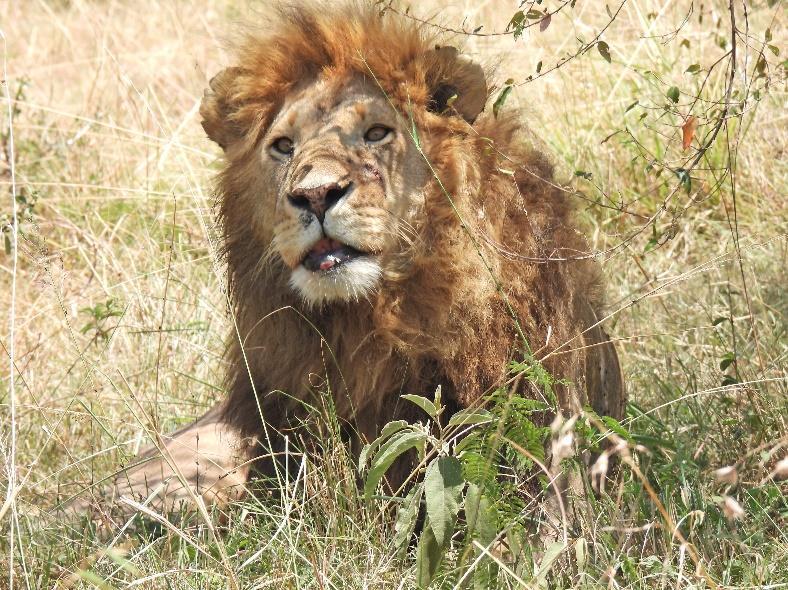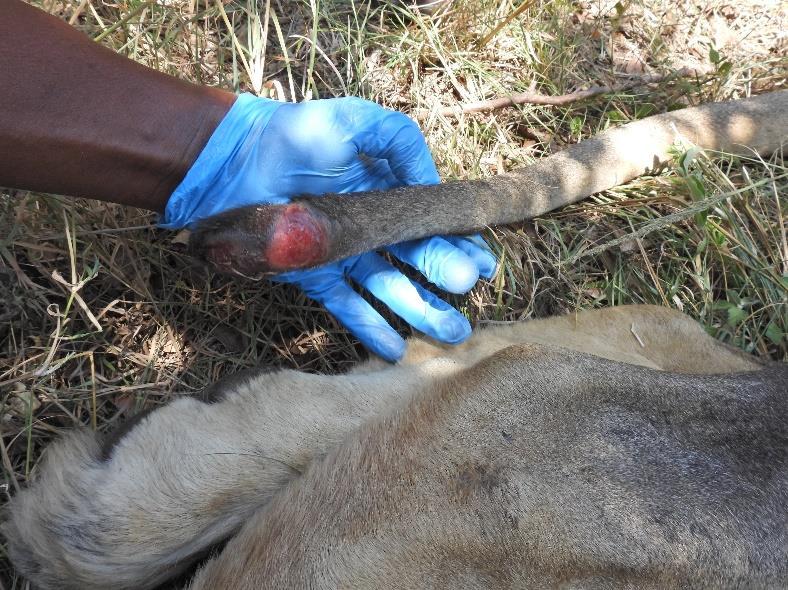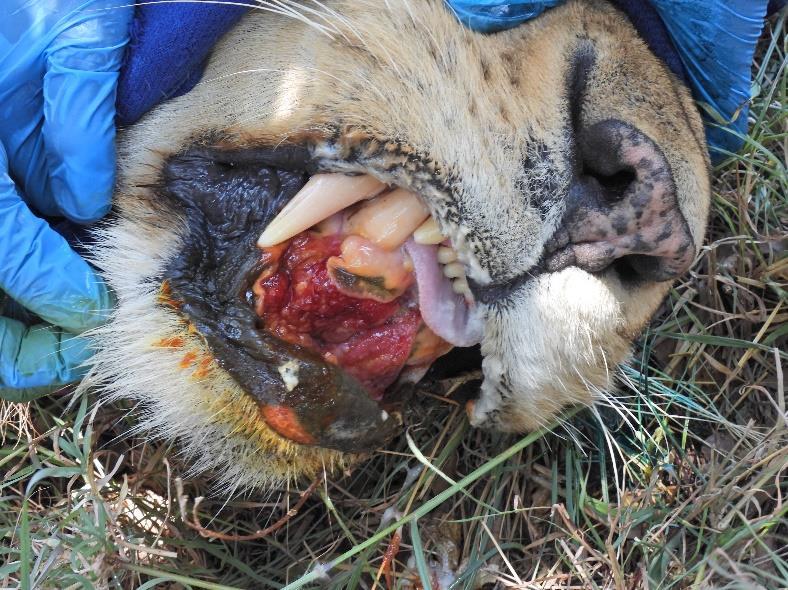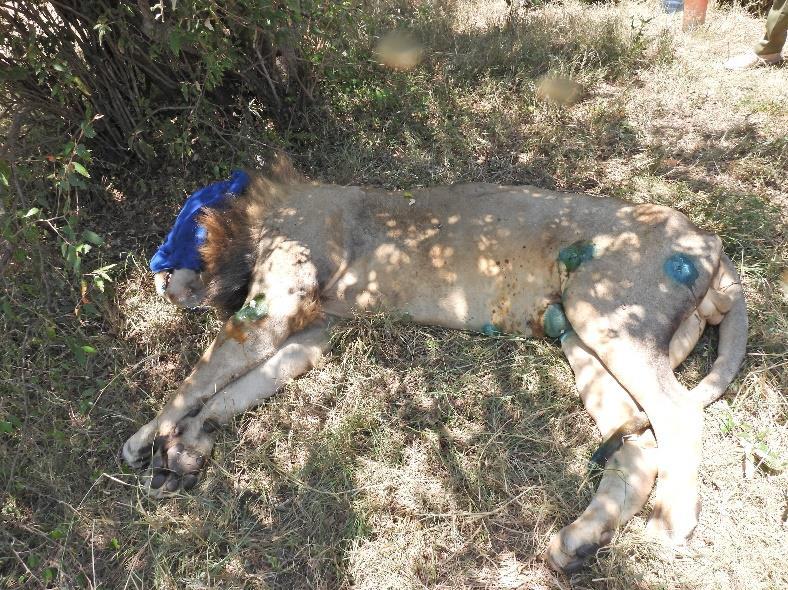

SWT/KWS MARA MOBILE VETERINARY UNIT
SEPTEMBER 2025





18 Cases in September 2025 10 Poaching Cases 10 Elephant Cases
September Report by Dr. Michael Njoroge
The Unit attended 18 cases in September, including 10 elephant cases and 10 poaching cases. The poaching cases involved 2 arrowed giraffes and 8 elephants with spear and arrow wounds, plus one postmortem where human involvement was indicated but the exact cause of death couldn’t be identified.
Acknowledgement
The Mara Mobile Veterinary Team greatly appreciates Elizabeth Scarlett for funding the Unit through the Sheldrick Wildlife Trust. The team also thanks Kenya Wildlife Service for providing technical support and all the conservation partners who contributed to the success of veterinary interventions through timely reporting of veterinary cases and monitoring of treated animals.
SWT/KWS Mara Mobile Vet Unit Treatment Locations September 2025
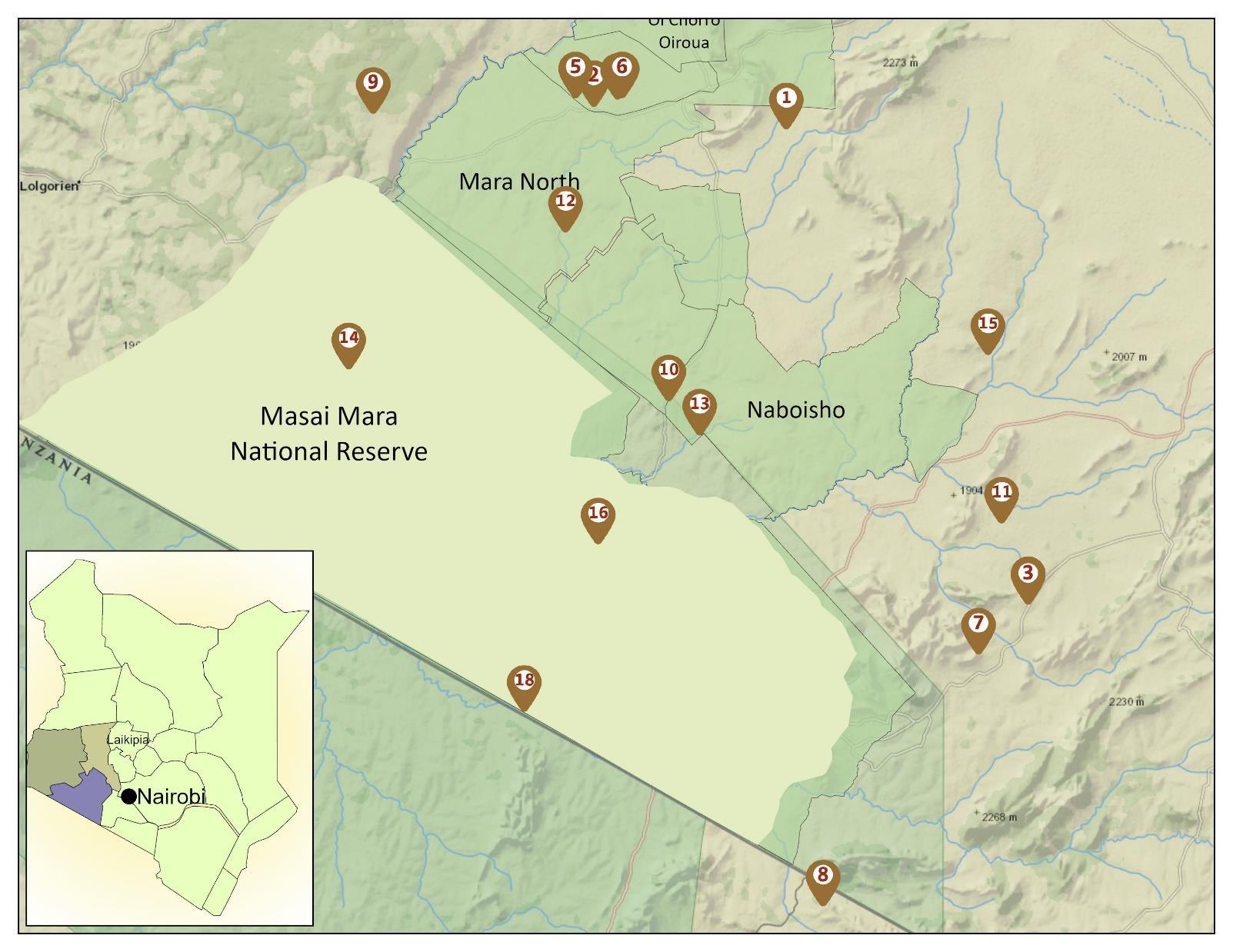
Case Details
1-Sep-25 Elephant Koiyaki Ranch Spear The elephant had a deep, septic penetrating spear wound Successfully Treated
5-Sep-25 Lion Masai Mara NR Natural Causes Likely a soft tissue strain or minor blunt trauma consistent with territorial fights Task Successful
9-Sep-25 Giraffe Sianna Conservancy Arrow Examination revealed a small metallic arrowhead lodged in the joint Successfully Treated
10-Sep-25
10-Sep-25
Masai Mara NR Natural Causes Noticeable limp of the right hindlimb Task Successful
Masai Mara NR Natural Causes Field reports suggested trauma following an altercation with a warthog Successfully Treated
11-Sep-25 Elephant Lemek Conservancy Postmortem The carcass was found lying in right lateral recumbency Died
15-Sep-25 Elephant Sianna Conservancy Poaching Postmortem The body was extensively putrefied, with significant bloating Poaching Death
15-Sep-25 Eland Olderkesi Conservancy Natural Causes A notable swelling on the left lateral abdominal region Successfully Treated
16-Sep-25
Oloisukut Conservancy Postmortem The carcass exhibited slight dehydration. All tusks were intact Died
18-Sep-25 Elephant Olare Motorogi Spear Multiple puncture wounds on the dorsal right flank consistent with spear injury Successfully Treated
18-Sep-25 Elephant Mara Ripoi Conservancy Arrow The elephant had a penetrating wound with a retained arrowhead visible Successfully Treated
26-Sep-25 Elephant Mara North Conservancy Spear A metal spear embedded and visibly protruding from the rear limb Successfully Treated
26-Sep-25 Elephant Naboisho Conservancy Spear Penetrating spear wound to the left flank region with secondary inflammation Successfully Treated
26-Sep-25 Elephant Masai Mara NR Spear The elephant had sustained an injury likely inflicted by a spear Successfully Treated
26-Sep-25 Elephant Olkinyei Conservancy Spear Penetrating spear wound to the spinal region at the thoracolumbar region Successfully Treated
29-Sep-25 Lion Masai Mara NR Natural Causes Femoral nerve injury of the right hindlimb and multiple soft tissue injuries
30-Sep-25 Giraffe Mara Ripoi Conservancy Arrow Wound injury at the left carpal joint, consistent with traumatic soft tissue injury Successfully Treated
30-Sep-25 Lion Masai Mara NR Natural Causes Deep laceration of the left external abdominis muscle and soft tissue injuries Successfully Treated
Case 1 – 1st September 2025
Elephant Spear Koiyaki Group Ranch
A report was received regarding a limping male elephant that was observed along the border between Pardamat and Mara North Conservancies. Rangers noted marked lameness in the left hind limb.
Immobilisation, examination and treatment
The elephant was immobilized with 18mg Etorphine using the Dan-inject system from a helicopter. The elephant was safely immobilized within 5 minutes and positioned on the right side for treatment.
Examination revealed a deep, septic spear wound localized at the hock joint region, presence of purulent discharge indicating active infection, necrotic tissue surrounding the wound margins and moderate limb swelling and marked lameness. The necrotic tissues in the infected wounds were debrided, and the pus was drained. The wounds were cleaned with water and Hydrogen peroxide, flushed with Iodine, sprayed with Oxytetracycline, packed with 3,340mg Cloxacillin cream then covered with Bentonite clay Anti-inflammatory: 3500 mgs Flunixin Meglumine and Antibiotic: 25000 mgs Amoxicillin were also administered intramuscularly.
Prognosis
Prognosis is good as the wound, although septic and deep, was adequately debrided and treated.
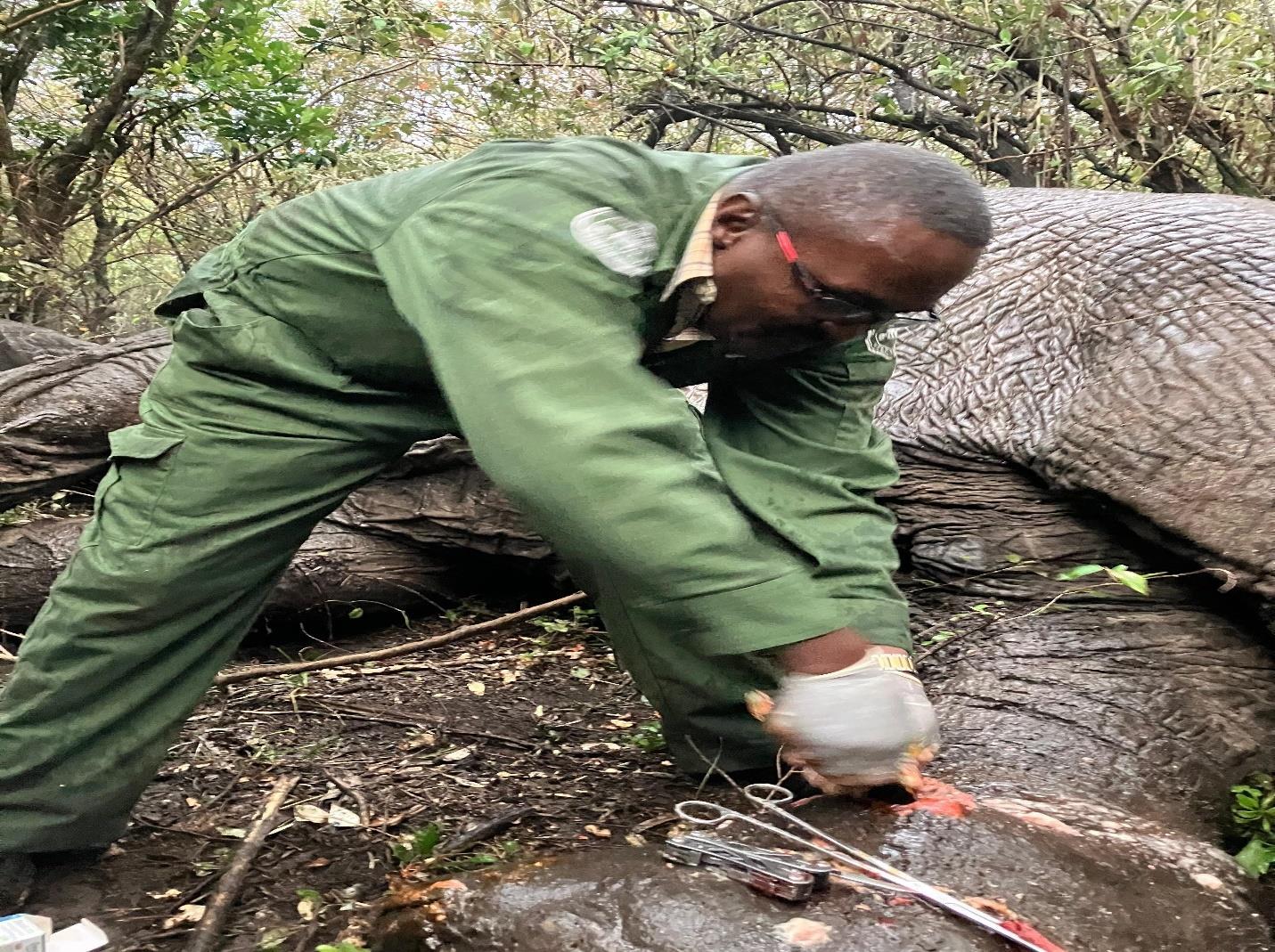
Case 2 – 5th September 2025
Lion
Natural Causes
Masai Mara National Reserve
Kini was reported to have sustained an injury. He was observed with mild swelling of the right carpal joint, but no open wounds, discharge, or signs of infection.
Examination
The Vet Unit attended the case and observed the lion who was in good body condition and exhibited normal behavioural with no indication of pain. It is most likely a soft tissue strain or minor blunt trauma consistent with territorial or intraspecific aggression, no signs of joint instability or fracture.
Prognosis
The adult male lion exhibits a minor injury localized at the right forelimb, clinically assessed as non-severe and non-progressive. Considering normal behaviour, feeding and good body condition, veterinary intervention was not warranted.

Giraffe Arrow
Sianna Wildlife Conservancy
A giraffe was exhibiting signs of forelimb lameness and reduced mobility with noted abnormal gait and visible purulent discharge from the left shoulder with a possible object lodged in the area.


Immobilisation, examination and treatment
The giraffe was immobilized with a combination of 15mg Etorphine mixed with 40mg Azaperone and it took approximately 6 minutes to full sedation. The giraffe was guided into lateral recumbency with the aid of experienced ground personnel using ropes to avoid injury. It was quickly revived using 300mg Naltrexone then restrained manually. Clinical examination revealed a small metallic arrowhead lodged at the left glenohumeral joint, associated with mild purulent discharge and localized swelling. Moderate cellulitis and tissue irritation were noted. Palpation revealed slight crepitus, but no overlying joint instability. No signs of systemic toxicosis, such as hyper salivation, tremors, or altered mentation observed. A 5cm barbed arrowhead was retrieved then the wound was thoroughly cleaned with Hydrogen peroxide and Iodine, packed with Cloxacillin ointment and sprayed with Oxytetracycline. The giraffe was also given 50mg Meloxicam anti-inflammatory and 2000mg Amoxicillin antibiotic
Prognosis
Long-term outcomes are expected to be positive, with full restoration of the joint function likely.
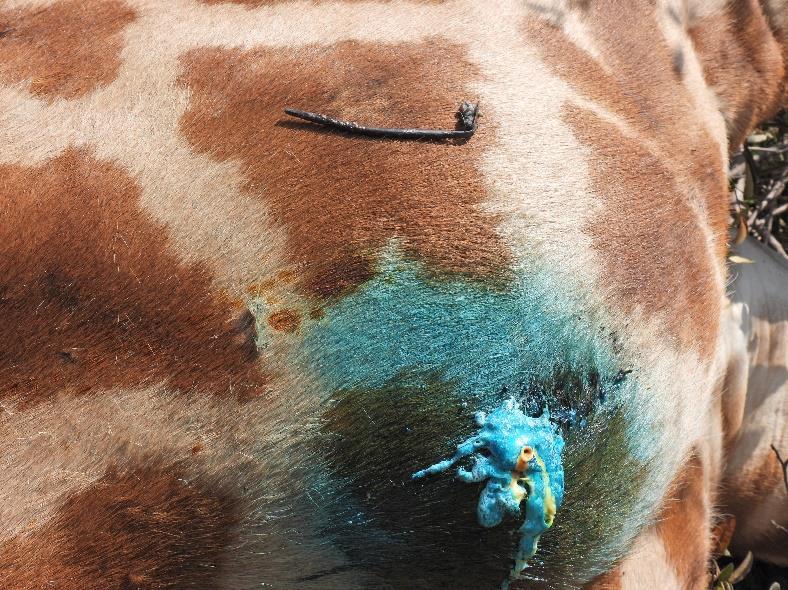
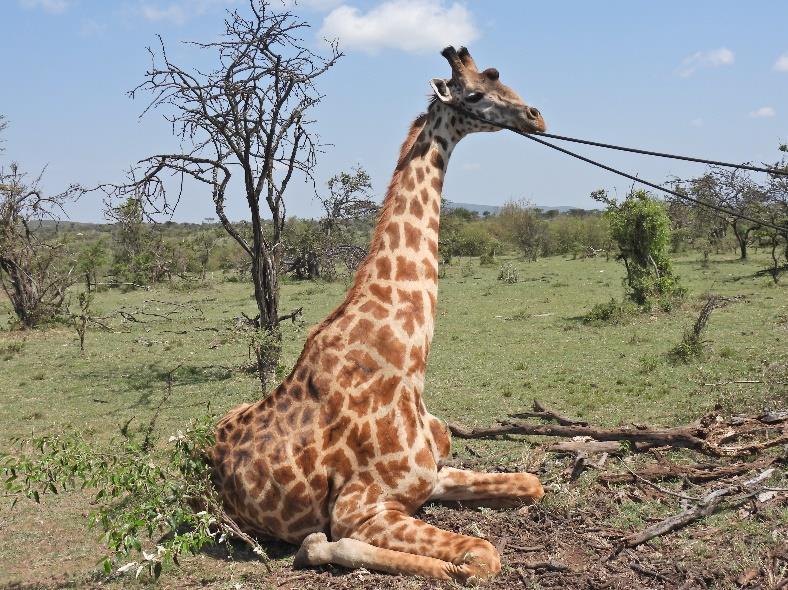
Case 4 – 10th September 2025
Lion
Natural Causes
Masai Mara National Reserve
An adult lioness belonging to the Rongai pride was observed exhibiting a noticeable limp affecting the right hind limb. According to the field reports, the injury was sustained during an encounter with a warthog, likely as a result of defensive behaviour during a predatory event. No external open wounds or visible bleeding were reported. The lioness remained ambulatory, although she exhibited reduced weight-bearing and intermittent periods of rest.
Examination
The lioness displayed a clear right hindlimb limp, characterized by shortened stride length, and mild circumduction She was in good body condition, capable of walking but avoided placing full pressure on the affected limb during slow movement and was alert and responsive. No visible laceration, swellings, or joint deformities were noted. No evidence of bleeding. Soft tissue avulsion, or subcutaneous emphysema. The respiratory rate and frequency of movement were within normal limits, with good body condition. She was likely suffering from a minor ligament strain with soft tissue trauma involving the quadriceps or hamstrings.
Prognosis
Due to the non-critical nature of the injury, no pharmacological intervention was administered.

Lion
Natural Causes
The lioness is a known member of a resident pride currently raising cubs. Field reports suggested trauma following an altercation with a warthog during an attempted predation event.
Examination and treatment
The adult lioness was alert but lethargic, resting with limited ambulation, lactating, and accompanied intermittently by cubs. On close examination, the injury revealed a superficial laceration over the lateral aspect of the left scapula, mild localized oedema with no signs of gross purulence, no fractures or deep tissue involvement identified via visual assessment. Due to the presence of cubs and potential risks of separation or abandonment, immobilization using general anaesthesia was deemed inappropriate. A conservative yet effective remote intervention approach was adopted. The lioness was administered 50mg Meloxicam antiinflammatory and 1,200mg Amoxicillin antibiotic remotely via a dart gun.
Prognosis
Prognosis is good. The injury is classified as a mild soft tissue trauma. Administration of a long-acting antibiotic provides sufficient systemic coverage. Ongoing monitoring and daily visual checks for wound healing, gait normalization, and continued maternal engagement were recommended to the rangers
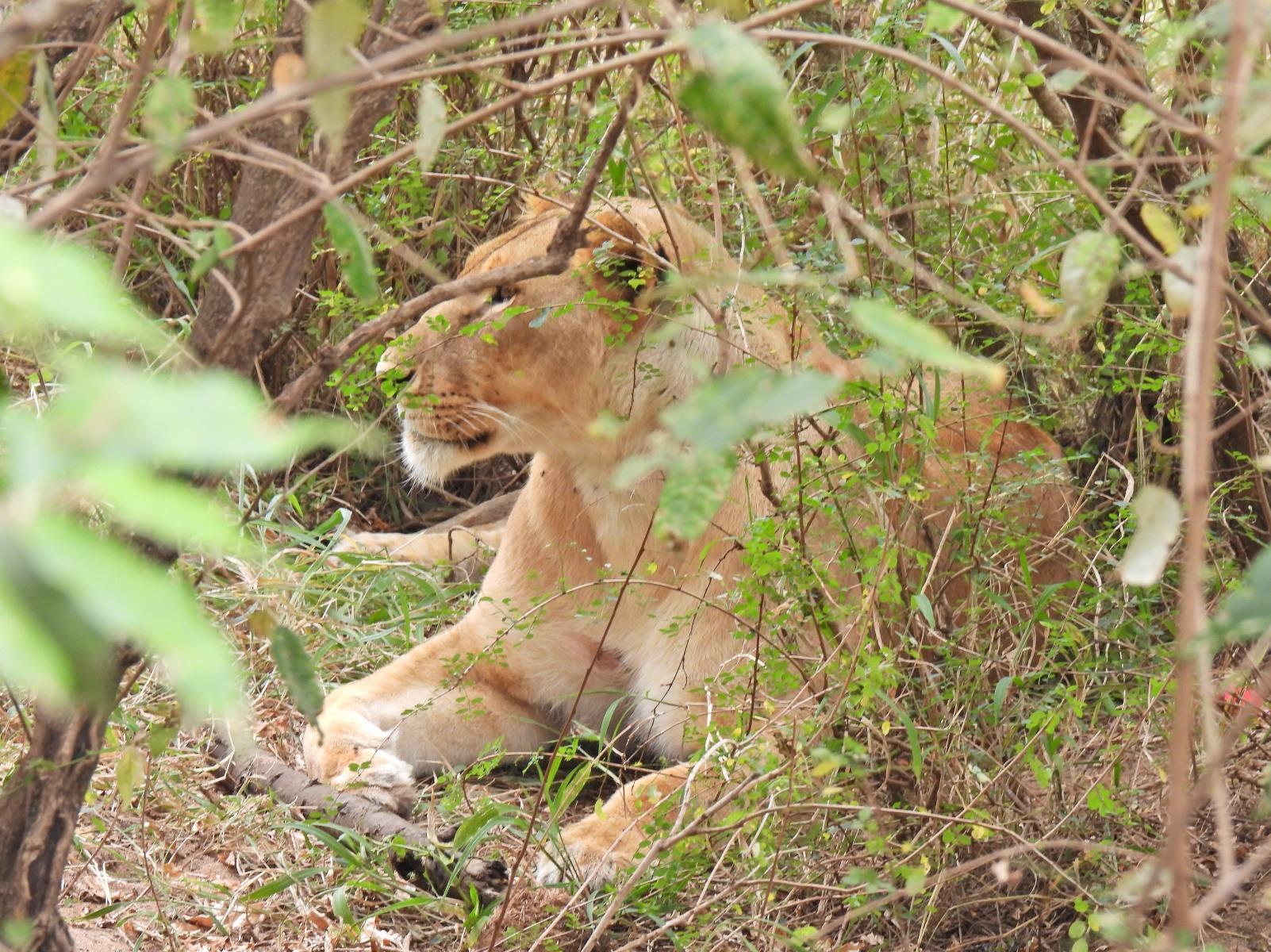
Masai Mara
Postmortem
Lemek Wildlife Conservancy
The carcass was found lying in right lateral recumbency, limbs extended, with mild bloating. No visible signs of external trauma or haemorrhage were observed. Both tusks were intact and unaltered.
Postmortem examination
The body condition was fair, with moderate subcutaneous fat stores, mild to moderate bloating with earlystage putrefaction, no fractures or dislocations noted, intact skin, no lesions or abrasions besides the gluteal muscles of the right hindlimb extending to the hip bone, which had been partially scavenged on.
Internally there was moderate gaseous distension, with intact mucosa. No trauma or muscle degeneration observed. The spleen was enlarged and congested with putrefaction setting in. Liver and lungs, and other significant internal organs had undergone advanced autolysis.
Cause of death
Natural death likely due to systemic disease of non-infectious ethology. No signs of anthrax, haemorrhagic disease, or infectious disease. It is recommended that the elephant population within Lemek Conservancy be monitored.
.
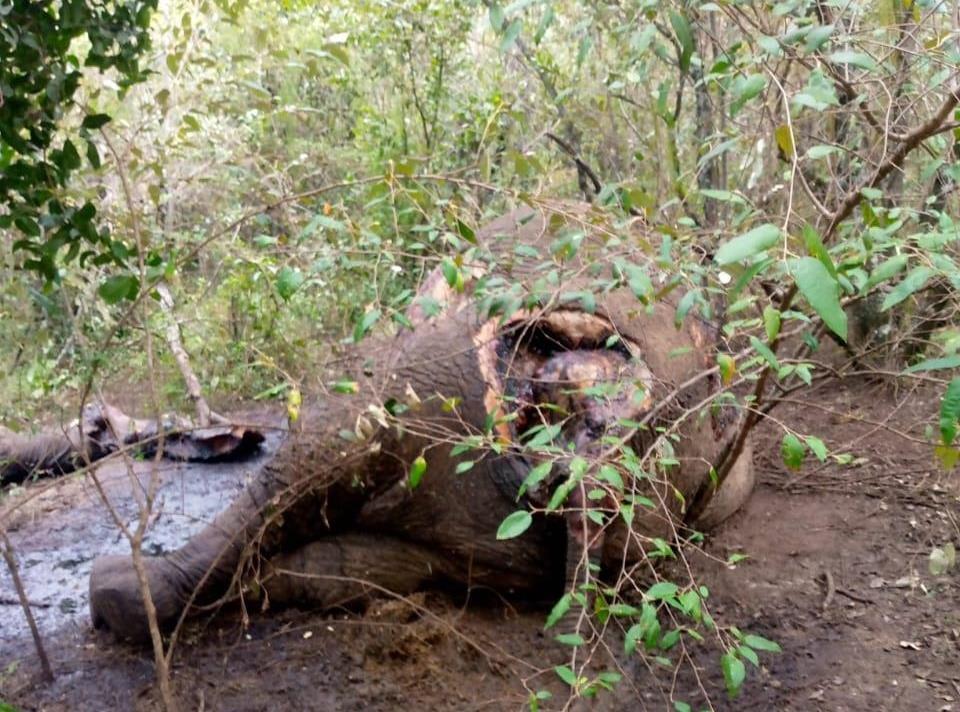
Elephant Poaching Postmortem Lashe, Sianna Conservancy
A fully grown adult male African elephant was found in an advanced stage of decomposition. The body was extensively putrefied, with significant bloating and collapse of soft tissues. The skull and portions of the thoracic skeleton were externally exposed due to tissue degradation and scavenger activity. The surrounding area showed signs of scavenging by both vertebrate and invertebrate species, as expected in carcasses left exposed in open terrain for extended periods. The hide was largely sloughed, and internal organs were no longer identifiable in situ due to advanced decomposition
Postmortem examination
Due to the complete putrefaction and skeletal exposure, a thorough internal examination could not be performed, and no significant necropsy findings could be collected. The individual was naturally a monotusker with only a right tusk present; however, the right tusk was also absent and had been physically removed. Following investigations and community engagement the tusk was recovered from local community members and handed to KWS.
Cause of death
Inconclusive due to advanced decomposition, with a single tusk missing, indicative of probable poaching
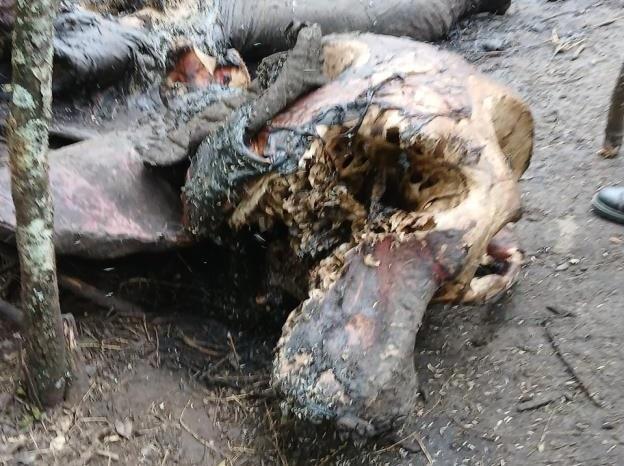
Case
Eland Natural Causes
Olderkesi Conservancy
Wildlife rangers observed the adult female eland to be displaying signs of discomfort and reduced mobility with a notable swelling on the left lateral abdominal region suspected to be sustained during a fight.
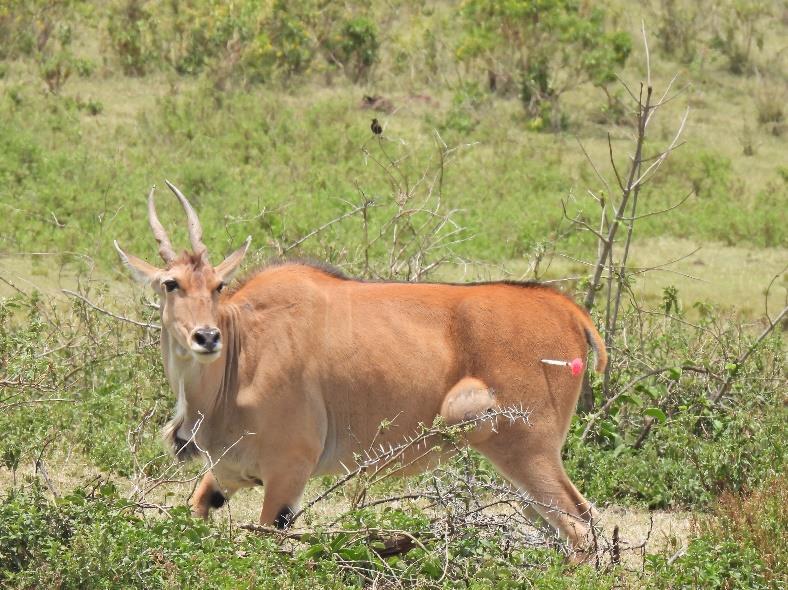
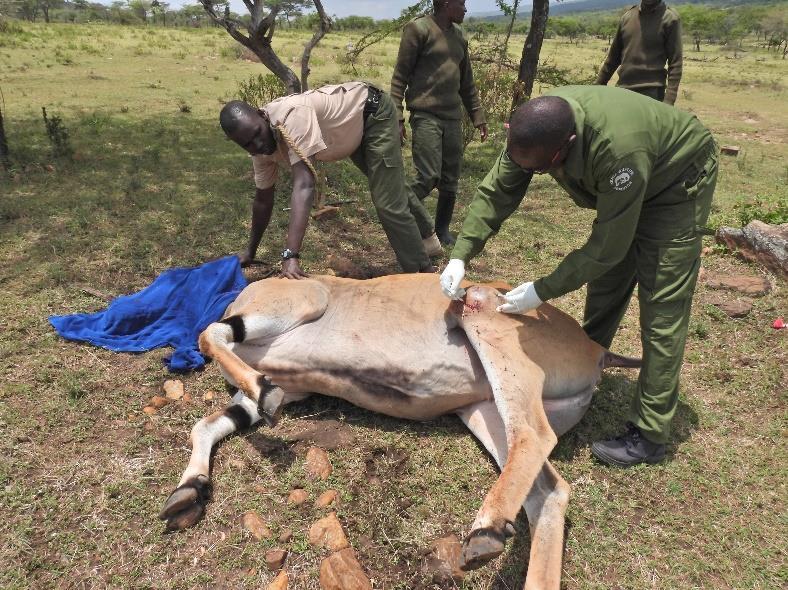
Immobilisation, examination and treatment
Given the size and nature of the species, chemical immobilization was employed. 10mg Etorphine hydrochloride mixed with 60 mg of Azaperone hydrochloride
The injury was located on the left abdominal wall, mid-lateral region, penetrating wound approximately 5-6 cm in diameter, marked swelling, minimal seropurulent exudate, moderate response to palpation with no evidence of deep organ involvement or peritonitis noted externally. The wound was thoroughly cleaned with water, debrided with Hydrogen peroxide and irrigated with Iodine then packed with 3,340mg Cloxacillin ointment and sprayed with Oxytetracycline. The eland was also administered 6,000mg Amoxicillin and 1,000mg Flunixin meglumine intramuscularly.
Relocation, revival and prognosis
Due to the timely intervention, the prognosis for full recovery is excellent. Follow-up monitoring is advised to ensure the absence of abscess formation or secondary infection
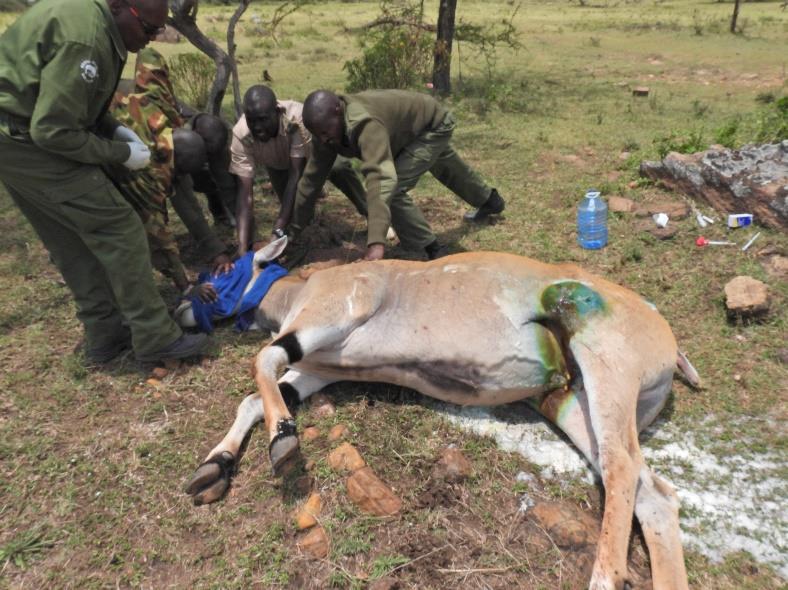
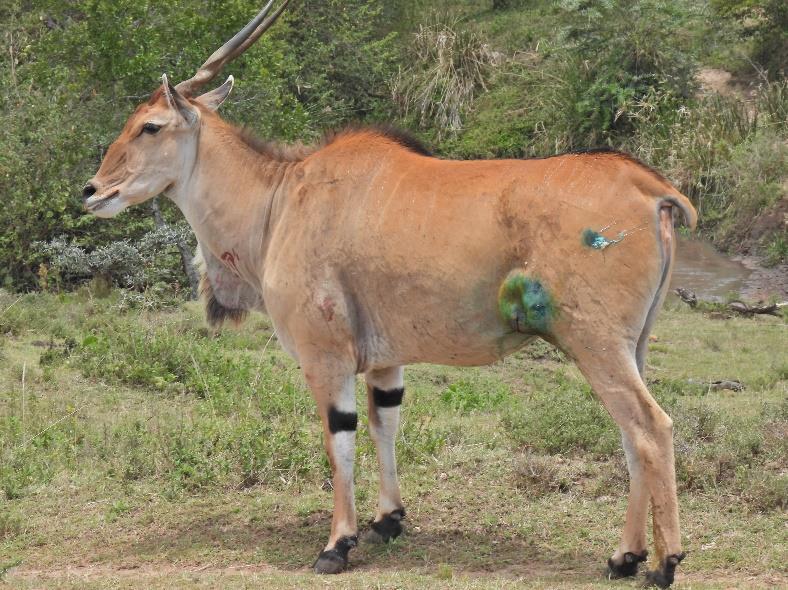
Case
Elephant Postmortem
Oloisukut Conservancy
The elephant carcass was reported to the Mara Elephant Project by Oloisukut Rangers.
Postmortem examination
On external examination, the carcass exhibited slight dehydration. All tusks were intact, with no evidence of external trauma. No other external abnormalities were observed.
• Lungs were heavy, spongy, and oedematous, consistent with pulmonary oedema.
• Heart enlarged with multifocal sub-epicardial and myocardial haemorrhages
• Large volume of yellow serous fluid (ascites) in the abdominal cavity.
• Peritoneum markedly thickened, hyperaemic, and covered with fibrinous exudate, with multiple areas of coagulative necrosis (necrotizing fibrinopurulent peritonitis).
• Pus was distributed within the abdominal cavity, confirming septic peritonitis
• Stomach serosa with multifocal petechial and ecchymotic haemorrhages.
• Liver enlarged, friable, and yellowish, suggesting hepatic degeneration associated with septicaemia.
Cause of death
Multi-organ failure (cardiac and respiratory compromise secondary to septicaemia).
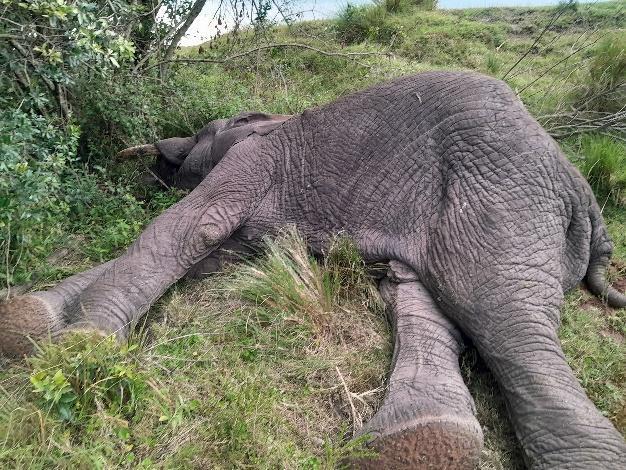
Case 10 – 18th September 2025
Elephant Spear
Olare Conservancy
A solitary adult female African elephant exhibiting signs of injury and behavioral signs was reported. Given the challenging terrain and the evasive nature of the animal, helicopter support was requested.
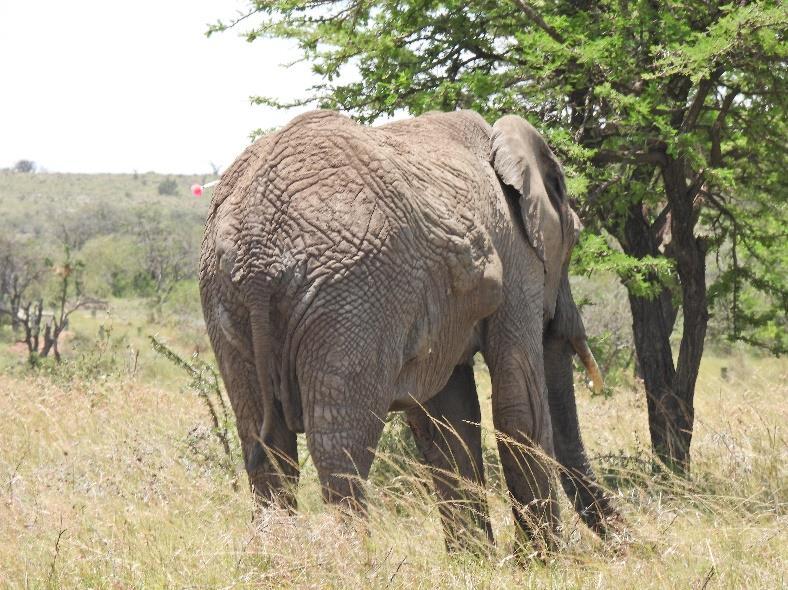

Immobilisation, examination and treatment
The elephant was immobilized with 15mg Etorphine intramuscularly using the Dan-inject system from a helicopter. The elephant was safely immobilized within 3 minutes
Examination revealed multiple puncture wounds on the dorsal right flank consistent with spear injury, extensive soft tissue swelling and superficial abrasions at the left lumbosacral region, a minor superficial laceration with minimal exudate at the ventral abdomen, and a large fluctuant abscess approximately 20cm in diameter. The abscess was lanced to evacuate purulent material then the necrotic tissues were debrided and pus drained. The wound was then lavaged with water, Hydrogen peroxide and Iodine, packed with Cloxacillin ointment and green clay then sprayed with Oxytetracycline. The elephant was also administered with 10,000mg Flunixin and 30,000mg Oxytetracycline.
Prognosis
Although the wound was deep and septic, the prompt treatment gives the elephant a good prognosis.
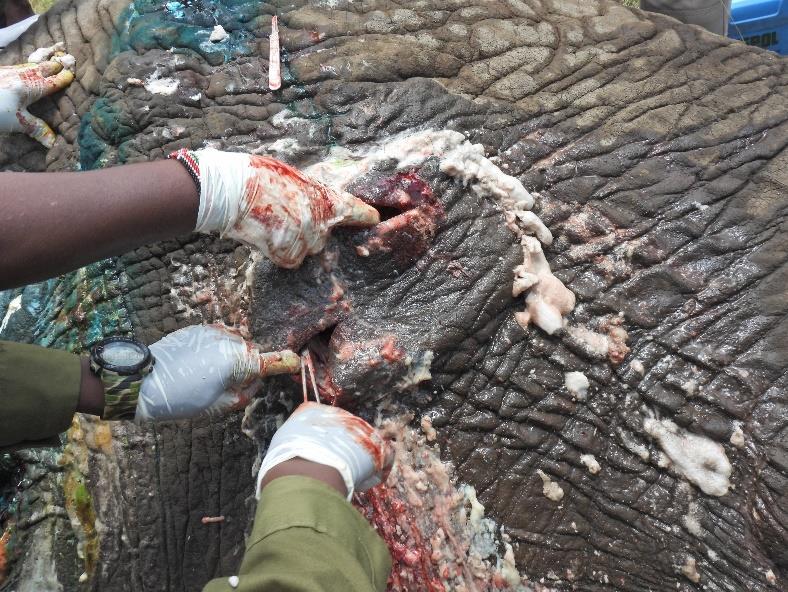
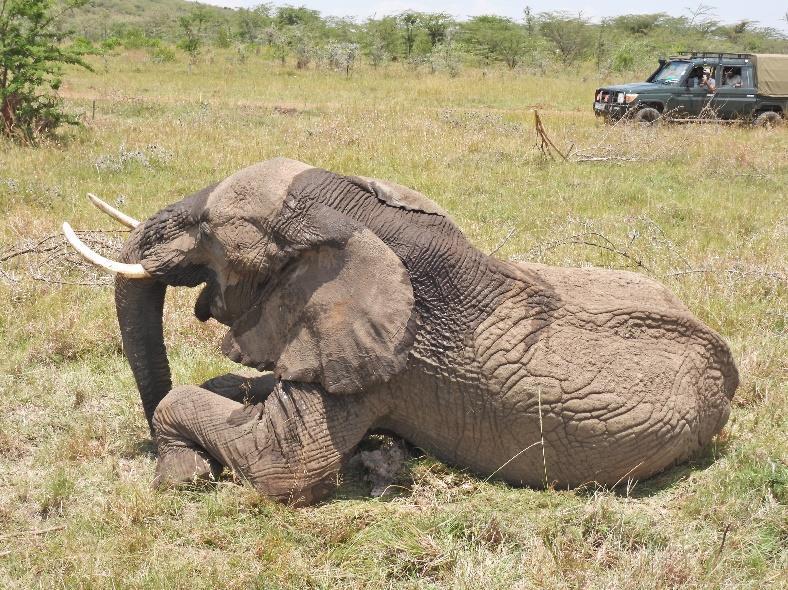
Case 11 – 18th September 2025
Elephant Arrow
Ripoi Wildlife Conservancy
The elephant was observed with visible external wounds, including one suspected to be caused by an embedded arrow Due to the elephant’s large size and rough terrain, aerial support was requested.
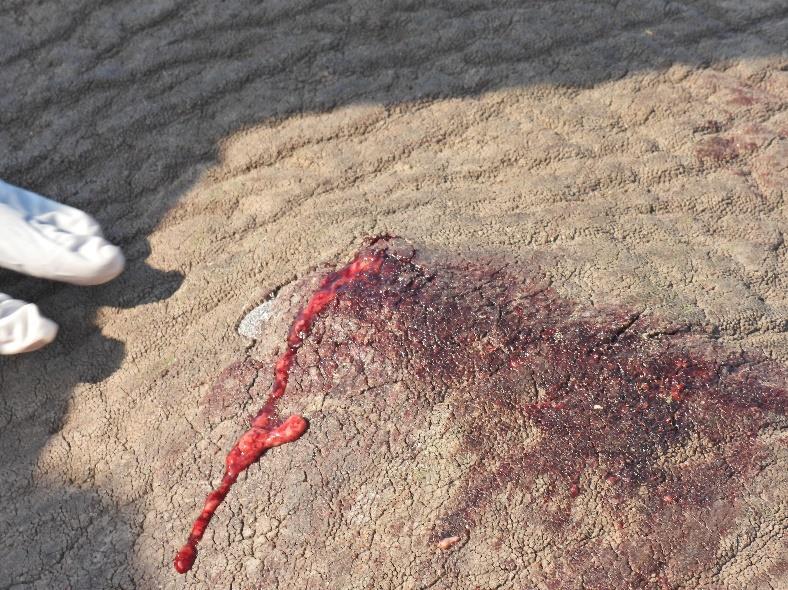
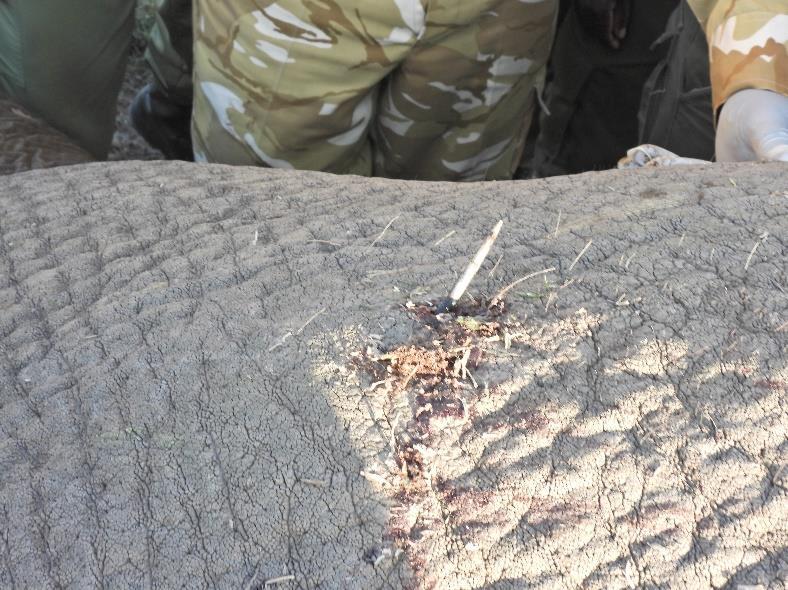
Immobilisation, examination and treatment
The elephant was immobilized with 18mg Etorphine using the Dan-inject system delivered from a helicopter. The elephant was safely immobilized within 7 minutes post-darting on the left lateral recumbency.
Examination revealed a fresh soft tissue laceration about 10cm diameter, with a mild haemorrhagic exudate but no foreign object on the right dorsal flank and a penetrating wound with a retained arrowhead visible subcutaneously on the left dorsal thoracic region. The arrowhead was successfully retrieved then the wounds were cleaned with water, debrided with Hydrogen peroxide and Iodine to remove and necrotic and inflamed tissue. Cloxacillin cream (3,340mg) and topical Oxytetracycline spray were then applied. The elephant was also given 400mg Dexamethasone anti-inflammatory and 150,000mg Oxytetracycline antibiotic.
Prognosis
Prognosis is good following timely treatment and removal of the arrowhead. The wounds were fresh, with minimal necrosis or signs of chronic infection, further supporting a favourable outcome .

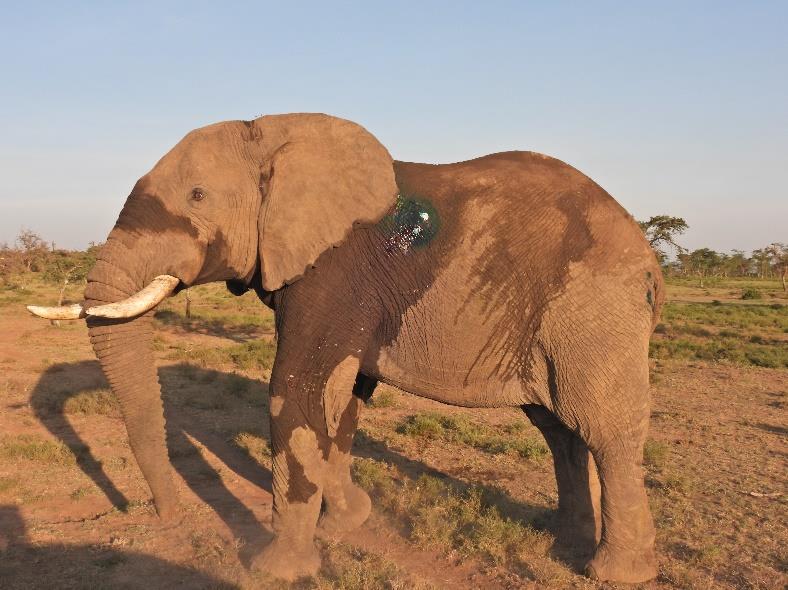
Case 12 – 26th September 2025
Elephant Spear Mara North Conservancy
The elephant had reportedly been sighted with visible signs of distress and physical trauma, consistent with spear injuries. Due to the rough terrain, aerial support was requested.
Immobilisation, examination and treatment
The elephant was immobilized with 15mg Etorphine intramuscularly using the Dan-inject system from a helicopter. The elephant was safely immobilized within 4 minutes post-darting.
Examination revealed a metal spear embedded and visibly protruding from the rear limb. The surrounding tissue exhibited swelling, haemorrhage, and purulent discharge, indicating secondary bacterial infection and a deep penetrating spear wound anterior to the base of the left ear, extending approximately 8-10cm in depth. The wound was necrotic at the margins and exudating fluid; no evidence of damage to the auditory canal was observed, though soft tissue trauma was significant. The spear was carefully removed and necrotic tissues debrided and cleaned with water, Hydrogen peroxide and Iodine then covered with Cloxacillin cream and sprayed with Oxytetracycline. The elephant was also given 15,000mg Flunixin and 30,000mg Amoxicillin.
Prognosis
Prognosis is good following timely treatment


Case 13 – 26th September 2025
Elephant Spear
Naboisho Conservancy
An elephant was reportedly limping and showing signs of pain. The elephant was identified as being in fair body condition but displayed visible discomfort and partial non-weight-bearing on the left hind limb. A penetrating wound consistent with a spear injury was observed on the left flank region.
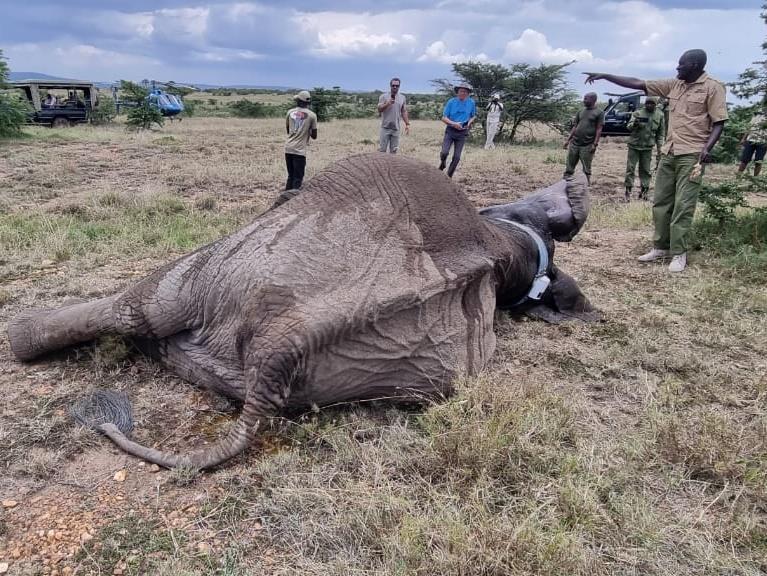

Immobilisation, examination and treatment
The elephant was immobilized with 15mg Etorphine intramuscularly using the Dan-inject system from a helicopter. The elephant was immobilized within 3 minutes
Examination revealed a wound on the left flank region, between the last rib and the hip. The wound was approximately 18cm in length and 5-6 cm in depth. The wound was fresh with signs of erythema and swelling, and minimal purulent discharge. No signs of necrosis and extensive tissue devitalization and no foreign object detected within the wound. The wound was cleaned with water and Hydrogen peroxide then flushed with Iodine, Cloxacillin cream and Bentonite clay were packed into the wound then it was sprayed with Oxytetracycline. The elephant was administered 10,000mg Flunixin and 30,000mg Amoxicillin to cover for inflammation and infection.
Prognosis
The prognosis is good as there was minimal tissue damage, and the elephant was in good body condition

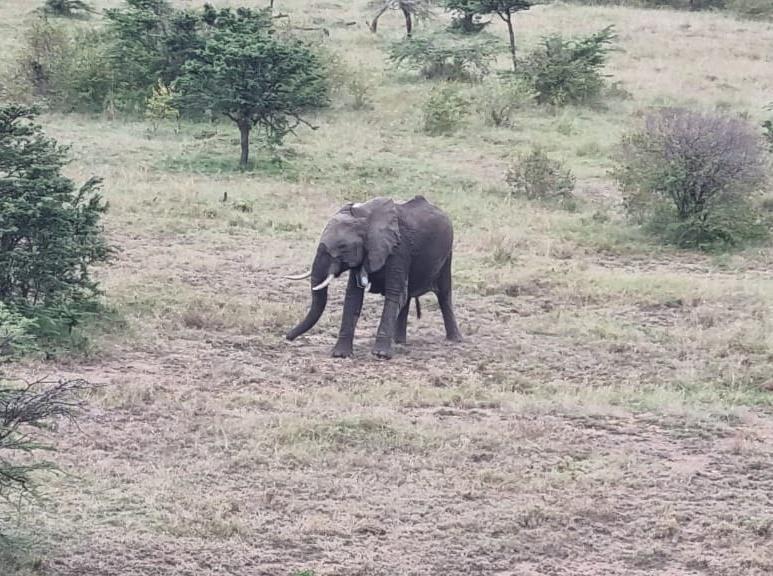
Case 14 – 26th September 2025
Elephant Spear
Ngerende Wildlife Conservancy
The Vet Unit received a report from Community Rangers concerning an adult female elephant exhibiting abnormal posture and restricted head movement. The elephant was also reported to be solitary
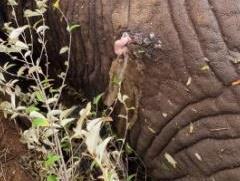
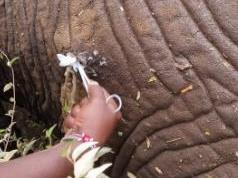
Immobilisation, examination and treatment
The elephant was immobilized with 17mg Etorphine intramuscularly using the Dan-inject system from a helicopter. The elephant was immobilized within 3 minutes
Clinical examination revealed a single penetrating wound with a surrounding localized swelling and purulent exudate on the lateral aspect of the mid-cervical region, approximately 40cm caudal to the base of the skull. The overall body condition was good (3.5/5). The necrotic tissues in the infected wounds were debrided and the pus drained. The wounds were lavaged with water followed by Hydrogen peroxide then flushed with Iodine. Cloxacillin cream and topical Oxytetracycline spray were applied on the wounds. The elephant was also given 10,000mg Flunixin and 30,000mg Amoxicillin to cover for inflammation and infection.
Prognosis
The prognosis is fair to good following timely intervention and treatment. The wound, although septic and deep, was adequately debrided and treated with systemic and topical antibiotics

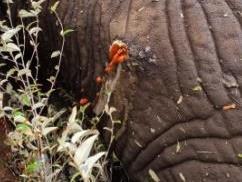
Case
Elephant Spear
Olkinyei Conservancy
According to the field personnel, the elephant had been sighted limping and moving sluggishly, with visible signs of trauma on the dorsal region likely caused by a spear.

Immobilisation, examination and treatment
The elephant was immobilized with 18mg Etorphine intramuscularly using the Dan-inject system from a helicopter. The elephant was immobilized within 3 minutes
Clinical observation revealed a single, penetrating wound approximately 20cm deep and 4cm in diameter at the thoracolumbar region of the spine, approximately at the level of T12-L1 vertebrae, most likely a spear injury. Surrounding tissue showed signs of acute inflammation with no foreign object detected on probing. The wound was thoroughly lavaged with a copious amount of sterile water, followed by hydrogen peroxide, and antiseptic irrigation using a tincture of diluted povidone Iodine Finally, cloxacillin cream and Oxytetracycline spray were applied to the wounds. 25,000mg Amoxicillin and 10,000mg Flunixin were administered to the elephant to help with inflammation and infection.
Prognosis
The prognosis is good as the injury was localized with no evidence of deep tissue infection
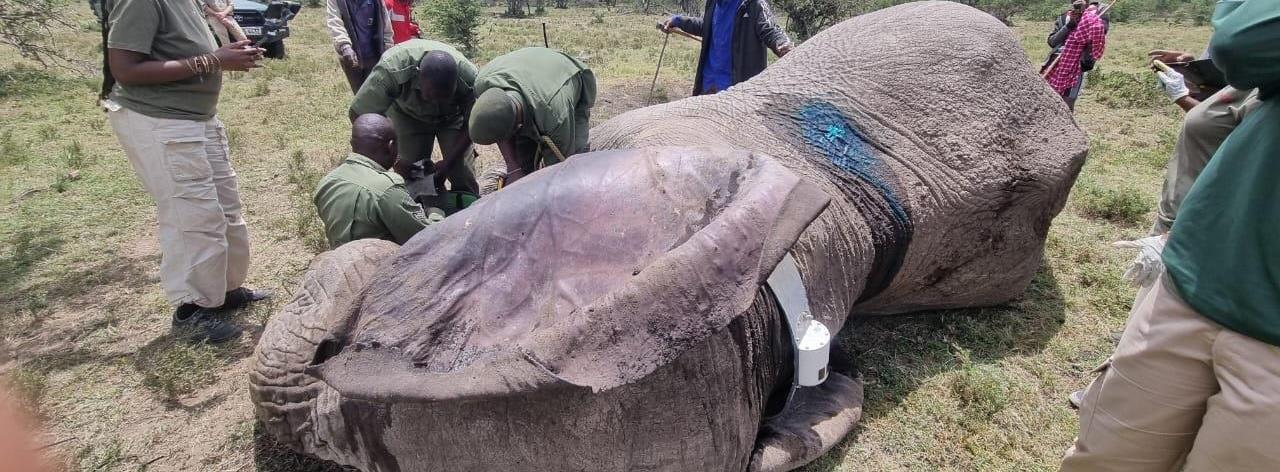
Case 16 – 29th September 2025
Lion
Natural Causes
Masai Mara National Reserve
The lioness had been reported earlier with the injury, but she disappeared. Upon being located, the lioness was observed to be limping, favoring her right hind limb, frequently lying down, and showing visible wounds. The lioness was presumed to have sustained trauma during hunting.
Immobilisation, examination and treatment
The lioness was immobilized with the chemical immobilization protocol involving the use of Ketamine 300mg mixed with 6mg Medetomidine hydrochloride administered via darting from a vehicle at a safe distance
A thorough examination revealed marked muscle atrophy and wasting of the right hindlimb, a superficial bruise at the right pinna, a lacerative wound at the ventral great oblique muscle of the left flank, and a deep laceration at the right elbow joint. The right hindlimb had an absence of voluntary motor function, diminished patellar reflex and withdrawal reflex. All the wounds were cleaned with water, Hydrogen peroxide and Iodine then sprayed with Oxytetracycline. 50mg Meloxicam and 22,50mg Amoxicillin were administered to reduce inflammation and prevent secondary infection.
Prognosis
The prognosis is good though due to the chronic muscle wastage, full motor recovery maybe prolonged.
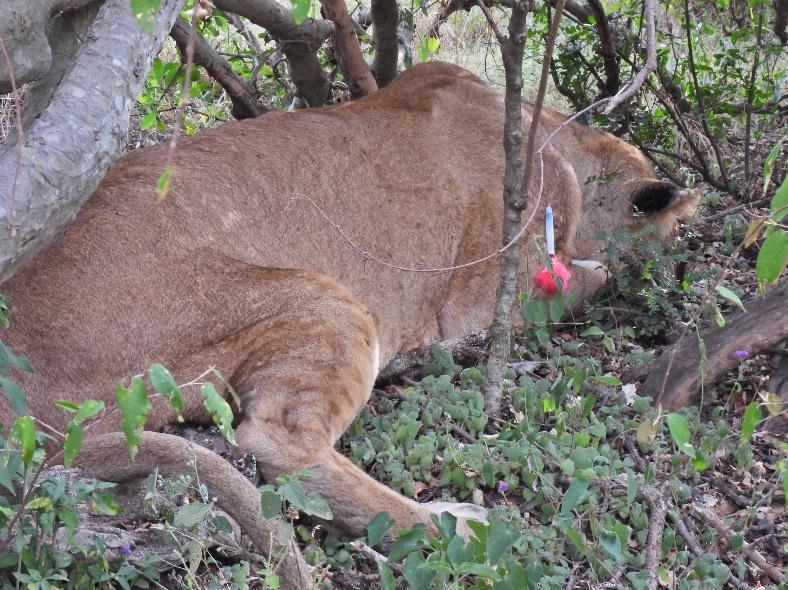
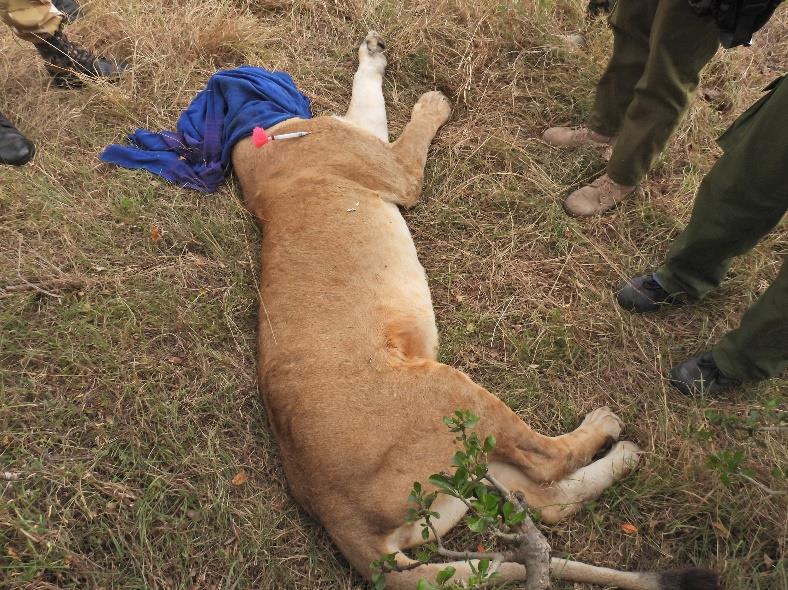
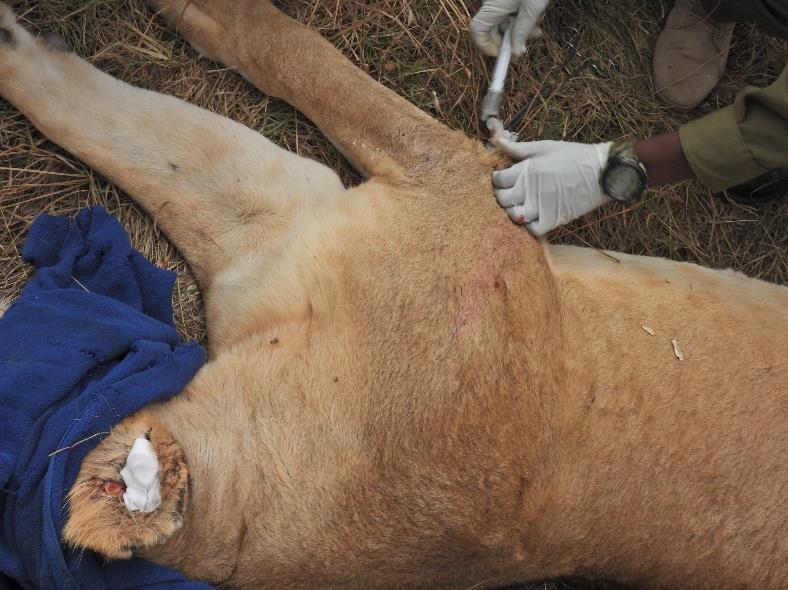
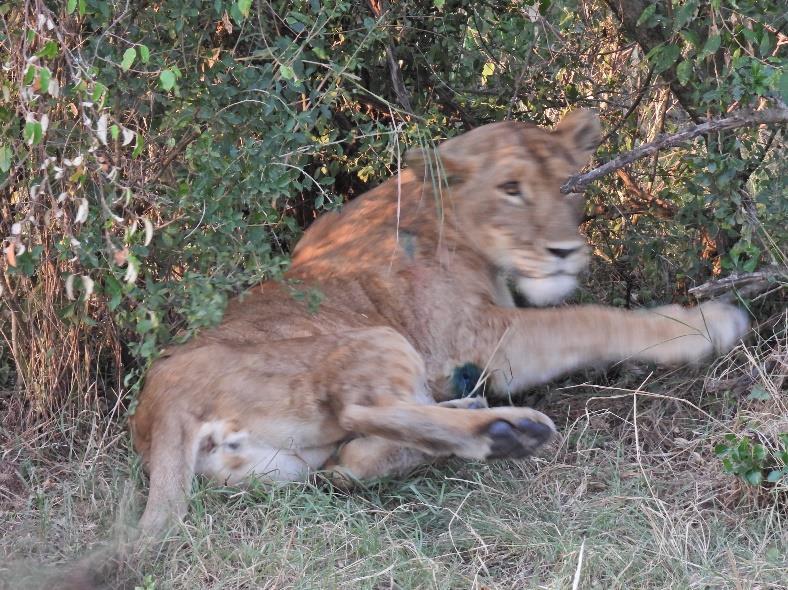
Case 17 – 30th September 2025
Giraffe Arrow
Mara Ripoi Conservancy
The giraffe was exhibiting lameness in the left forelimb and a visible wound around the carpal joint area. The giraffe was in open grassland within the conservancy, showing alert behavior but reduced mobility.
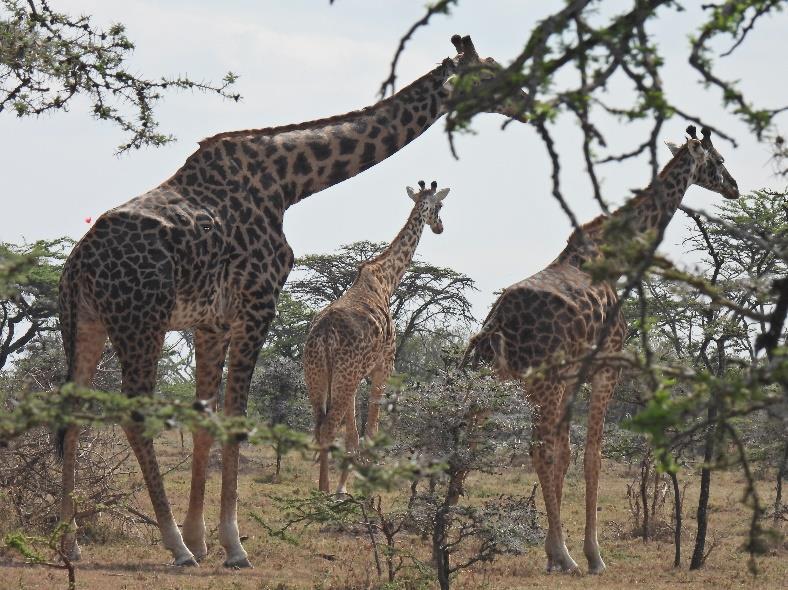
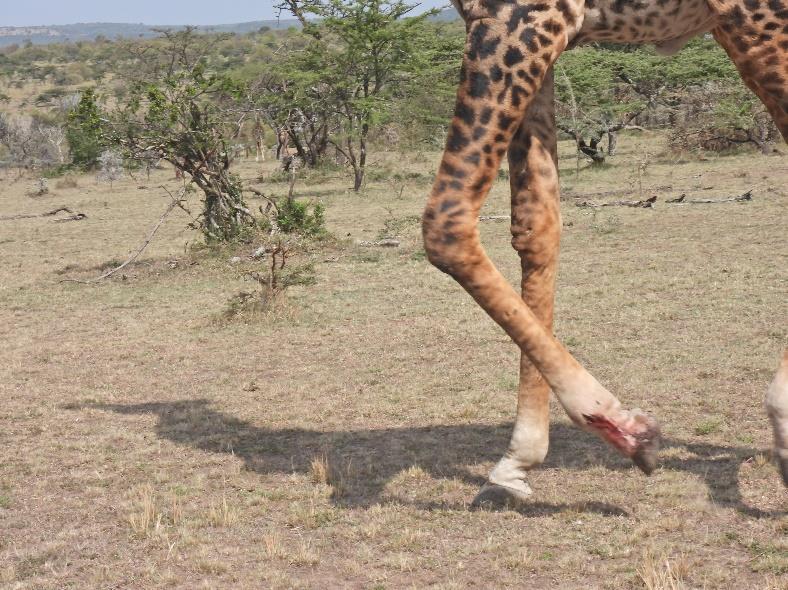
Immobilisation, examination and treatment
The giraffe was immobilized using a combination of 15mg Etorphine mixed with 30mg Azaperone. The giraffe took approximately 5 minutes to reach full sedation. The giraffe was guided into lateral recumbency with the aid of experienced ground personnel using ropes to avoid injury. It was quickly revived using 300mg Naltrexone. The giraffe was maintained on the ground by manual pinning of the head and neck.
Examination revealed a penetrating wound located at the carpal joint of the left forelimb, extending through the dermal layer with exposure of subcutaneous tissue and a minor laceration at the right auricle (pinna), superficial and clean, with no evidence of hemorrhage The wound was debrided and thoroughly cleaned using an antiseptic solution then lavaged with Hydrogen peroxide. Cloxacillin ointment and Oxytetracycline spray were applied topically. 600mg Dexamethasone and 20,000mg Amoxicillin were also administered.
Prognosis
The prognosis is good due to the giraffe's good body condition, and absence of deep structural involvement

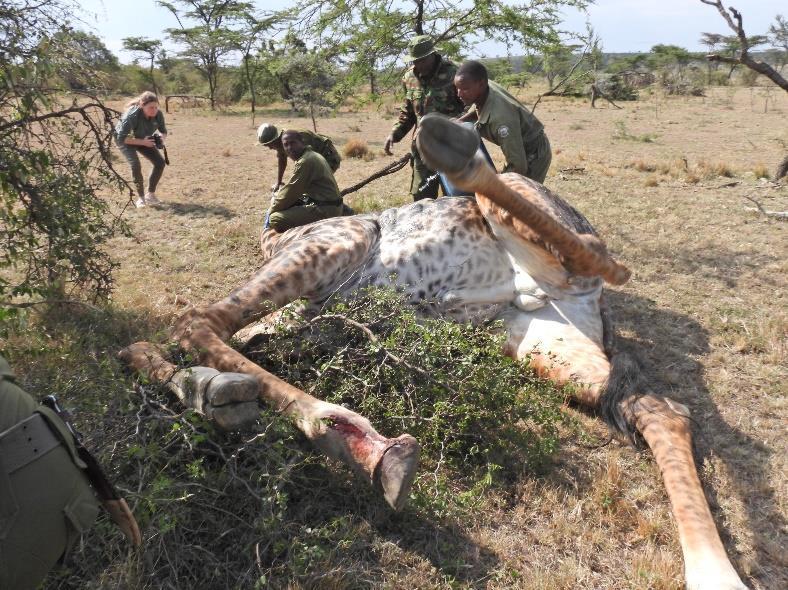
Case 18 – 30th September 2025
Lion
Natural Causes
Masai Mara National Reserve
The lion exhibited signs of distress and limited movement favoring the right hindlimb, and a wound on the abdominal muscles, suggesting trauma and injury The lion was found resting, alert but with limited mobility.
Immobilisation, examination and treatment
The lioness was immobilized with the chemical immobilization protocol involving the use of Ketamine 300mg mixed with 8mg Medetomidine hydrochloride administered via darting from a vehicle at a safe distance.
A clinical examination revealed a deep laceration on the left external oblique abdominis muscle, extending through the skin and subcutaneous tissue. Multiple superficial bruises were noted on the tail, hamstring, and shoulder regions, consistent with fight-related injuries. The wounds were thoroughly cleaned using sterile water to remove debris then lavaged with Hydrogen peroxide, disinfected with Iodine and sprayed with Oxytetracycline. The abdominus muscle laceration was sutured in two layers and the skin closed with a simple interrupted suture to promote optimal healing and minimise tension. The lion was then administered a longacting broad-spectrum antibiotic, 2,000mg Amoxicillin and anti-inflammatory; 60mg Meloxicam.
Prognosis
The intervention successfully stabilized the injury, and the lion is expected to resume normal activity
